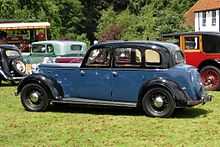Rover 16
| Rover 16 | |
|---|---|
 P2 six-light saloon body with 16hp 2.2 litre engine, 1947 | |
| Overview | |
| Manufacturer | Rover |
| Production |
1937–1940 1945–1948 |
| Body and chassis | |
| Body style |
four-door “six-light” saloon four-door “four-light” "sports saloon" two-door cabriolet |
| Powertrain | |
| Engine | 2147 cc straight 6 |
| Dimensions | |
| Wheelbase | 113 in (2,870 mm)[1] |
| Length | 175 in (4,445 mm) |
| Width | 62.5 in (1,588 mm) |
| Chronology | |
| Predecessor | Rover Speed 16 |
| Successor | Rover P3 |
The Rover 16 was a medium-sized family car produced by the British Rover car company between 1937 and 1940 as a successor to the Rover Speed 16. It reappeared in 1945 following the Second World War and remained on sale until replaced by the Rover P3 in 1948.
The car, with its mildly streamlined form, resembled the existing Rover 10 and the Rover 12 but was slightly longer and featured a more rounded back end. The six-cylinder ohv engine had a capacity of 2,147 cc. A top speed of 124 km/h (77 mph) was claimed. In addition to the four-door saloon, a two-door cabriolet was available, normally referred to as a drophead coupé, with bodywork by Tickfords.
The sports saloon and the drophead coupé had slightly less length between the front and rear seats, but a longer bonnet, with the front footwell extending further beneath the bonnet.
A version called the Rover 14 saloon combined the same body with (from 1938) a 1,901 cc six-cylinder engine. There was also a version called the Rover 20 with a 2512 cc. engine.
Notable features included a "freewheel" system, Bijur-Luvax automatic lubrication of the chassis, and Girling rod actuated fully compensated mechanical brakes of exceptionally high efficiency.
The Rover 16 saloon returned to production almost unchanged after the war, although the cabriolet version was no longer listed.

